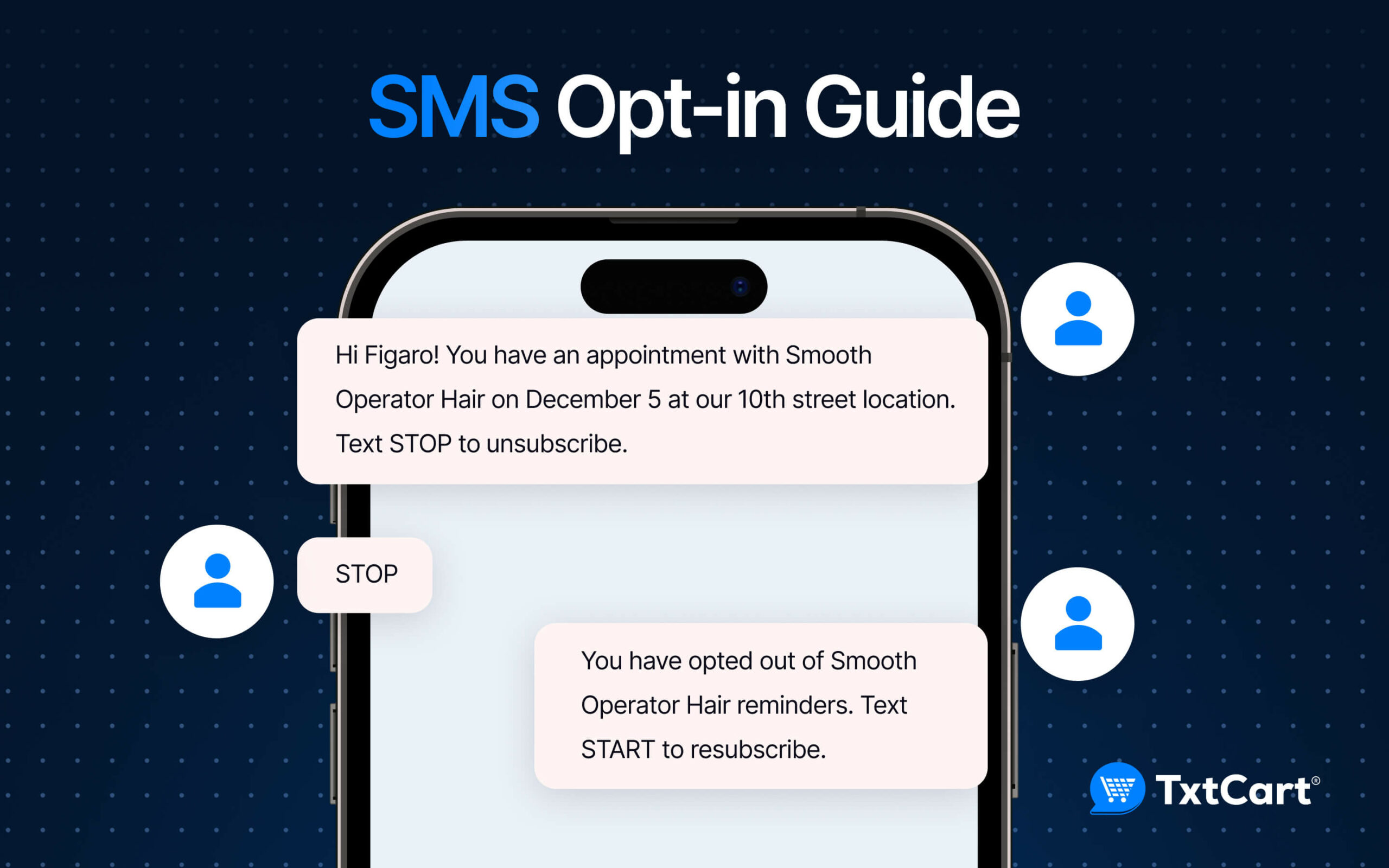Sending unsolicited text messages to your customers is like barging into a party uninvited. It ticks people off, it’s illegal, and you’ll lose out on building a solid customer base.
We understand that convincing people to share their numbers can be tricky, but the core of a successful SMS campaign is adhering to SMS opt-in best practices. You can gain trust and build a strong relationship with your audience by getting their explicit permission to send messages. It also reduces the chance of receiving spam complaints, leading to better and more positive customer experiences.
This article will tell you everything you need to know about using SMS opt-ins for your brand.
What is SMS opt-in?
SMS opt-in messages are requests for permission to send text messages to a user’s mobile device. These messages seek explicit consent, ensuring compliance with privacy regulations. Users must willingly agree to receive communications, promoting a respectful and legal approach to engaging with the audience through text messaging.
Your SMS opt-in process involves three key stages:
- The opt-in mechanism: How customers request to receive your brand’s texts, often through web pop-ups, links in emails, or texting a specific keyword to your SMS code.
- A confirmation message: Prompts customers to text a keyword to verify their consent, creating a double opt-in, now the SMS marketing standard.
- The initial text: Kicks off your official conversation, thanking subscribers, offering incentives, and introducing your brand.
Why is SMS opt-in important?
Permission-Based Marketing: Obtaining users’ permission before sending promotional messages shows respect for users’ privacy, which helps build trust and positive perceptions of the brand.
User Engagement: Opted-in users are more likely to engage with and respond positively to SMS messages, as they are genuinely interested in receiving communications from the business.
Relevance and Personalization: Enables businesses to tailor messages based on user preferences, making the content more relevant and engaging, capturing the user’s attention, and driving desired actions.
Reduced Spam Complaints: Ensures that messages reach the intended audiences, reducing the risk of users marking messages as spam as they have willingly opted to receive communications.
Cost-Efficiency: Optimizes marketing budgets by focusing on users who have expressed genuine interest.
Brand Image and Loyalty: Contributes to a positive brand image by demonstrating ethical and responsible communication practices.
Data Accuracy: Helps maintain accurate and up-to-date contact information as users are more likely to provide valid and current details during the opt-in process.
Also Read: Best SMS Marketing Examples To Supercharge Your Marketing Campaigns
What are the SMS opt-in requirements?
Let’s look into some of the important SMS opt-in requirements to be followed by businesses to follow compliances:
Express Consent
Individuals must provide explicit consent to receive SMS communication from a particular sender. Consent is typically obtained through an opt-in mechanism, such as checking a box on a website, sending a keyword to a shortcode, or filling out a consent form.
Clear Disclosure
When obtaining consent, it’s essential to disclose the nature of the messages the user will receive, including the frequency and content. Users should be informed about what they are signing up for.
Simple Opt-In Mechanism
Provide a clear and easy-to-use mechanism for users to opt into receiving SMS messages. Users should not be subscribed to SMS services without their knowledge or consent. Pre-checked boxes are generally not considered valid consent.
Double opt-in
Double opt-in includes sending a confirmation message after the initial opt-in, confirming the individual’s intent to receive messages. This two-step process minimizes the risk of unintended subscriptions and aligns with privacy regulations; hence, this method is widely endorsed for its reliability in confirming user consent.
Opt-Out Option
Users should have a straightforward way to opt-out of receiving SMS communication. This is often done by replying to the received message with a specific keyword (e.g., “STOP”). Opt-out requests should be processed promptly.
Compliance with Regulations
Businesses must comply with local and international SMS communications regulations, such as the Telephone Consumer Protection Act (TCPA) in the United States or the General Data Protection Regulation (GDPR) in the European Union guidelines.
Maintaining Opt-in and Opt-out records
Businesses must maintain meticulous records of opt-ins, documenting when, where, and how consent was given. Honoring opt-out requests promptly is equally important to respect individuals’ preferences and maintain compliance. Prioritize transparency, consent, and regulatory adherence, boosting a trustworthy and respectful relationship between brands and consumers.
Examples of businesses getting SMS opt-in
Here are some examples of SMS opt-in strategies used by businesses:
1. Keyword Opt-Ins
You text a specific keyword to a designated number to subscribe or receive information. It’s the most effective method as users retain information better. For example, on a billboard, texting “house” to the number associates “house” with “shire” whenever it’s mentioned.
2. Web Forms
Your visitors fill out a form on a website, opting in to receive SMS notifications or updates. Web forms encourage proactive opt-ins, allowing visitors control to receive SMS updates, ensuring engagement. It captures user details and allows personalized content, boosting SMS effectiveness.
3. Checkout Opt-ins
Checkout opt-ins allow customers to subscribe to SMS alerts or promotions during their purchase, enhancing engagement and convenience. To increase check out opt- in offer the benefits clearly, simplify the process, offer incentives, ensure it’s optional, and use straightforward language.
4. QR Code Opt-Ins
QR Code Opt-ins use scanned codes for subscription or information. They’re effective for quick access. Create by generating QR codes linked to subscription pages using online QR code generators or specialized software.
5. CTA Opt-Ins
Call-to-action opt-ins allow users to subscribe through compelling messages. They’re effective for instant engagement. Create them with clear, action-oriented language, strategically placed buttons on websites or ads, and link them directly to WhatsApp or to subscription forms or pages for a seamless user experience.
Also Read: Everything you need to know about SMS Marketing Analytics and KPI measurement
SMS opt-in guidelines to follow
Here are some SMS opt-in guidelines that businesses must follow:
1. Provide value
Clearly communicate the opt-in details, emphasizing frequency, content relevance, and any associated charges. Share interesting and valuable content that matches what they like. When you provide value, people are likely to stick around, trust your brand, and feel good about being part of your community.
2. Easy and seamless
Keep opting in simple, whether using a website pop-up, a texted keyword, or a checkout checkbox. Opt-ins should result from an active decision, avoiding pre-checked boxes or confusing language. Prioritize clarity to guarantee that users consciously choose to subscribe. This straightforward approach ensures a hassle-free and transparent opt-in process, respecting users’ choices and building trust in your communication strategy.
3. Keep it Concise
Keep messages concise, brief, and simple so people can quickly understand and respond. Make sure your content is clear, avoiding complicated details. Prioritize simplicity to make things easy for your audience.
4. Omni-channel contact options
Give people different ways to contact you when they sign up for SMS, like a website link, email, or phone. Offering options makes it easy for people to reach out and connect with you.
5. Call-to-option (CTA)
Create a clear and compelling CTA to encourage action, like “Text YES to join” or “Click to subscribe.” Make it straightforward and appealing, prompting users to take the next step easily.
6. Opt-out information
Ensure transparency by providing easy-to-follow instructions for subscribers to opt-out if they no longer want to receive messages. Include clear information on unsubscribing, respecting users’ choices, and promoting a straightforward and user-friendly opt-out process.
7. Personalization
Allow users to customize their preferences and the type of content they want to receive. By allowing users to customize their preferences, you respect their choice, enhance engagement, and nurture a more meaningful connection between your brand and your customers.
Best ways to increase SMS opt-ins
While there are several ways to increase SMS opt-ins or subscribers, here are some of our favorites:
1. Offer exclusivity
Create a sense of exclusivity by enticing users to subscribe for unique content or exclusive events. Offering special benefits promotes repeat engagement, setting your brand apart from one-time incentives and establishing long-term connections.
2. Timing is key
Choose the right time to ask for opt-ins. For example, after a successful purchase, during a special event, or after providing valuable content.
3. Optimize frequently
Consistently fine-tune your strategies through A/B testing and experimenting with various approaches. This iterative process lets you identify what resonates most effectively with your audience, ensuring constant optimization for better results.
4. Build trust
Establish trust by showing how much you care about their privacy and the value they get from being a part of your community. Let them know you’re committed to keeping their information safe and respecting their choices, creating a trustworthy connection.
5. Share social proof
Share testimonials or examples of positive experiences from current subscribers to build trust and credibility. Let their positive experiences speak for your brand, reinforcing trust and showcasing the real value of opting in.
6. Provide limited-time offers
Generate urgency by showcasing exclusive, time-sensitive deals for SMS subscribers. Highlight specific offers, such as “25% off,” to eliminate ambiguity and drive quick action, motivating conversions within a limited timeframe.
7. Provide segmented offers
Give different perks to different groups. For loyal customers, provide higher discounts, while new subscribers may receive freebies. This way, everyone gets something they like, making them more likely to join.
8. Ask for feedback
Ask your subscribers what they think! Getting feedback helps you understand what they like and what they don’t. This information is gold—it enables you to improve your messages and keep them interested.
What is SMS opt-out, and how do you control it?
SMS opt-out, also known as SMS unsubscribe or SMS opt-out compliance, refers to the process by which SMS recipients indicate they no longer wish to receive such messages.
It’s a crucial aspect of SMS marketing to ensure that businesses comply with regulations and respect their customers’ preferences. It is also about building and maintaining a positive relationship with your audience. Respecting their preferences and providing an easy and transparent opt-out process contributes to a positive customer experience.
Here are the critical aspects of controlling SMS opt-out:
1. Clear opt-out instructions
Provide clear and easily understandable instructions on how recipients can opt out of receiving SMS. This often involves including a simple keyword or shortcode in the message, such as “STOP” or “UNSUBSCRIBE.”
2. Automated opt-out system
Implement an automated system that processes opt-out requests promptly. When a recipient sends the designated opt-out keyword, the system should automatically remove their phone number from the distribution list and confirm the opt-out.
3. Opt-out confirmation
Send a confirmation message to the individual who opts out, confirming their request has been received and processed. It helps build trust and assures that you respect their preferences.
4. Maintain a list
Keep a record of individuals who have opted out to create a do-not-contact list. Update and check this list regularly to ensure that those who have opted out are not accidentally contacted in the future.
5. Strategize for re-engagement
To re-engage users who have unsubscribed:
- Focus on showcasing the value they are missing out on.
- Offer exclusive discounts or promotions to entice their return.
- Share interesting content and sneak peeks of upcoming deals to get them excited again.
- Show them the unique benefits they’ll enjoy if they return to encourage re-engagement.
Wrapping up
If you want to make the most of your SMS marketing efforts, following SMS opt-in guidelines is crucial. Sending opt-in text messages can be extremely effective when done right.
If you want to skip sending SMS blasts and provide a human touch with your SMS marketing, TxtCart is what you need.
With TxtCart, you can increase SMS opt-ins by automating campaigns for subscribers to ensure your messages reach your customers. Plus, with real-time replies from our live agents, you can offer a holistic customer experience.
Install Txtcart today to uncover the power of SMS marketing campaigns for your Shopify store.






